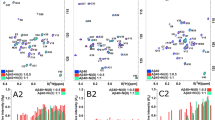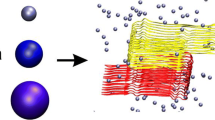Abstract
The group IIB elements, especially Cd(II) and Hg(II), are increasingly considered as potential environmental neurotoxins. This study demonstrates that the Alzheimer’s tau fragment R2, corresponding to the second repeat of the microtubule-binding domain, can bind to Zn(II), Cd(II) and Hg(II). Isothermal titration calorimetry experiments suggest that the most likely coordination site is the thiol group of Cys291, and this is further confirmed by a control experiment using a C291A mutant peptide. Circular dichroism spectrum reveals that the coordination of group IIB cations, especially Hg(II), can induce pronounced conformational conversions in natively unfolded R2, from random coil to other ordered structures. ThS fluorescence assays and electron microscopy indicate that the group IIB cations promote heparin-induced aggregation of R2, giving relatively small R2 filaments. The efficiency in promoting aggregation, as well as inducing conformational conversion, varies strongly with the cation’s polarizability. Based on these results, a model is proposed in which the cooperative folding of R2 through cross-bridging of group IIB cations is suggested to be a key factor in promoting aggregation, in addition to the effective neutralization of coulombic charge–charge repulsion by heparin, the poly-anion inducer. Our results provide clues to understanding the potential pathogenic role of group IIB metals in the development of neurofibrillary tangles, a typical hallmark of Alzheimer’s disease.






Similar content being viewed by others
References
Assaf SY, Chung SH (1984) Release of endogenous Zn2+ from brain tissue during activity. Nature 308:734–736
Barghorn S, Mandelkow E (2002) Toward a unified scheme for the aggregation of tau into Alzheimer paired helical filaments. Biochemistry 41:14885–14896
Bergen M, Barghorn S, Jeganathan S, Mandelkow EM, Mandelkow E (2006) Spectroscopic approaches to the conformation of tau protein in solution and in paired helical filaments. Neurodegenerative Dis 3:197–206
Bhattacharya K, Rank KB, Evans DB, Sharma SK (2001) Role of cysteine-291 and cysteine-322 in the polymerization of human tau into Alzheimer-like filaments. Biochem Biophy Res Co 285:20–26
Bocca B, Forte G, Petrucci F, Pino A, Marchione F, Bomboi G, Senofonte O, Giubilei F, Alimonti A (2005) Monitoring of chemical elements and oxidative damage in patients affected by Alzheimer’s disease. Ann Ist Super Sanita 41:197–203
Carmel G, Mager EM, Binder LI, Kuret J (1996) The structural basis of monoclonal antibody Alz50’s selectivity for Alzheimer’s disease pathology. J Biol Chem 271:32789–32795
Friedhoff P, Schneider A, Mandelkow EM, Mandelkow E (1998) Rapid assembly of Alzheimer-like paired helical filaments from microtubule-associated protein tau monitored by fluorescence in solution. Biochemistry 37:10223–10230
Ghoshal N, García-Sierra F, Fu Y, Beckett LA, Mufson EJ, Kuret J, Berry RW, Binder LI (2001) Tau-66: evidence for a novel tau conformation in Alzheimer’s disease. J Neurochem 77:1372–1385
Greenfield NJ (1996) Methods to estimate the conformation of proteins and polypeptides from circular dichroism data. Anal Biochem 235:1–10
Huang X, Atwood CS, Moir RD, Hartshorn MA, Vonsattel JP, Tanzi RE, Bush AI (1997) Zinc-induced Alzheimer’s Abeta1–40 aggregation is mediated by conformational factors. J Biol Chem 272:26464–26470
Jeganathan S, von Bergen M, Mandelkow EM, Mandelkow E (2008) The natively unfolded character of tau and its aggregation to Alzheimer-like paired helical filaments. Biochemistry 47:10526–10539
Jiang LF, Yao TM, Zhu ZL, Wang C, Ji LN (2007) Impacts of Cd(II) on the conformation and self-aggregation of Alzheimer’s tau fragment corresponding to the third repeat of microtubule-binding domain. Biochim Biophys Acta 1774:1414–1421
Johnson S (2001) Gradual micronutrient accumulation and depletion in Alzheimer’s disease. Med Hypotheses 56:595–597
Kelly SM, Jess TJ, Price NC (2005) How to study proteins by circular dichroism. Biochim Biophy Acta 1751:119–139
Liu GJ, Huang WD, Moir RD, Vanderburg CR, Lai B, Peng ZC, Tanzi RE, Rogers JT, Huang XD (2006) Metal exposure and Alzheimer’s pathogenesis. J Struct Biol 155:45–51
Massaro EJ (2002) Handbook of neurotoxicology. Humana Press Inc, Totowa
Minoura K, Yao TM, Tomoo K, Sumida M, Sasaki M, Taniguchi T, Ishida T (2004) Different associational and conformational behaviors between the second and third repeat fragments in the tau microtubule-binding domain. Eur J Biochem 271:545–552
Mo ZY, Zhu YZ, Zhu HL, Fan JB, Chen J, Liang Y (2009) Low micromolar zinc accelerates the fibrillization of human tau via bridging of Cys-291 and Cys-322. J Biol Chem 284:34648–34657
Mutter J, Naumann J, Sadaghiani C, Schneider R, Walach H (2004) Alzheimer disease: mercury as pathogenetic factor and apolipoprotein E as a moderator. Neuro Endocrinol Lett 25:331–339
Mutter J, Naumann J, Schneider R, Walach H (2007) Mercury and Alzheimer’s disease. Fortschr Neurol Psychiatr 75:528–538
Nelson DL, Cox MM (2004) Lehninger principles of biochemistry. W.H. Freeman, New York
Ngu-Schwemlein M, Merle JK, Healy P, Schwemlein S, Rhodes S (2009) Thermodynamics of the complexation of Hg(II) by cysteinyl peptide ligands using isothermal titration calorimetry. Thermochimica Acta 496:129–135
Sayre LM, Perry G, Harris PLR, Liu Y, Schubert KA, Smith MA (2000) In situ oxidative catalysis by neurofibrillary tangles and senile plaques in Alzheimer’s disease: a central role for bound transition metals. J Neurochem 74:270–279
Soragni A, Zambelli B, Mukrasch MD, Biernat J, Jeganathan S, Griesinger C, Ciurli S, Mandelkow E, Zweckstetter M (2008) Structural characterization of binding of Cu(II) to tau protein. Biochemistry 47:10841–10851
Su XY, Wu WH, Huang ZP, Hu J, Lei P, Yu CH, Zhao YF, Li YM (2007) Hydrogen peroxide can be generated by tau in the presence of Cu(II). Biochem Biophy Res Co 358:661–665
Thompson CM, Markesbery WR, Ehmann WD, Mao YX, Vance DE (1988) Regional brain trace-element studies in Alzheimer’s disease. Neurotoxicology 9:1–7
Tomoo K, Yao TM, Minoura K, Hiraoka S, Sumida M, Taniguchi T, Ishida T (2005) Possible role of each repeat structure of the microtubule-binding domain of the tau protein in in vitro aggregation. J Biochem 138:413–423
Uversky VN, Li J, Fink AL (2001) Metal-triggered structural transformations, aggregation, and fibrillation of human alpha-synuclein. A possible molecular NK between Parkinson’s disease and heavy metal exposure. J Biol Chem 276:44284–44296
Wille H, Drewes G, Biernat J, Mandelkow EM, Mandelkow E (1992) Alzheimer-like paired helical filaments and antiparallel dimers formed from microtubule-associated protein tau in vitro. J Cell Biol 118:573–584
Wu JF, Basha MR, Zawia NH (2008) The environment, epigenetics and amyloidogenesis. J Mol Neurosci 34:1–7
Yamamoto A, Shin RW, Hasegawa K, Naiki H, Sato H, Yoshimasu F, Kitamoto T (2002) Iron (III) induces aggregation of hyperphosphorylated tau and its reduction to iron (II) reverses the aggregation: implications in the formation of neurofibrillary tangles of Alzheimer’s disease. J Neurochem 82:1137–1147
Acknowledgments
This work was supported by the National Natural Science Foundation of China (Nos. 20871094, 20901060, 20472065). We thank the support of the opening foundation of the MOE key laboratory of Bioinorganic and Synthetic Chemistry, Sun Yet-Sen University.
Author information
Authors and Affiliations
Corresponding authors
Rights and permissions
About this article
Cite this article
Yang, DJ., Shi, S., Yao, TM. et al. Cooperative folding of tau peptide by coordination of group IIB metal cations during heparin-induced aggregation. Biometals 25, 361–372 (2012). https://doi.org/10.1007/s10534-011-9505-7
Received:
Accepted:
Published:
Issue Date:
DOI: https://doi.org/10.1007/s10534-011-9505-7




